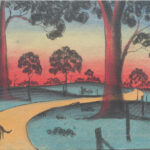New multi-disciplinary, international research has found that the appreciation of bees has been recognised throughout history and cultures, represented in diverse art forms from ancient carvings and historic cave art, to the big screen and across social media.
The study, published in Art and Perception, found evidence of bees depicted in an amazing array of art across time, cultures, and art mediums. This includes some of the oldest human representations cave art dating back more than 8,000 years old depicting humans collecting honey from a wild honeybee colony, Egyptian carvings and hieroglyphics and historic representations in China, as well as in music, architecture, films, and video games.
First author, Forrest Foundation Scholar Dr Kit Prendergast, from Curtin’s School of Molecular and Life Sciences, said the results confirmed a long-standing and positive association between bees and humankind.
“Looking back at some of the early records of human representations in cave art dating back more than 8,000 years to art by the ancient Mayans of South America, we found that humans have had an enduring relationship with bees. This was initially established with colonial bees, which provided humankind with the benefits of honey, wax, and crop pollination,” Dr Prendergast said.
“This aesthetic appeal endures today, with bees represented in a remarkable variety of mediums and platforms ranging from Pokémon characters, including Combee, to the 3D-printed beehive structure that NASA says could be our future home on Mars.
“These examples clearly show how bees have been deeply rooted in the way different people around the world perceive and relate to bees through creative practice.”
Dr Prendergast said that the study emphasised the power of using art to bring bees into our collective consciousness.
“There is increasing scientific and public awareness that bee species face many threats, including extinction due to the impact of the expansion of human industrialised living and agricultural practices, habitat fragmentation, climate change, increased urbanisation and pesticide use.
“Hopefully we can harness the aesthetic connection to bees shown in this study to support efforts to address the underlying threats that may drastically affect their future.
“There also needs to a greater appreciation of the wild, native bees, which are overshadowed by the European honeybee in research, funding, and representation.”
Co-author Associate Professor Adrian Dyer, from RMIT University, said it was amazing to think that for thousands of years different people from all around the world have chosen to represent bees in artwork.
“The frequent bee art themes show our common understanding in human culture of how important bees are to how we live and prosper,” Associate Professor Dyer said.
The full paper, titled Bee Representations in Human Art and Culture through the Ages, is available online here.



